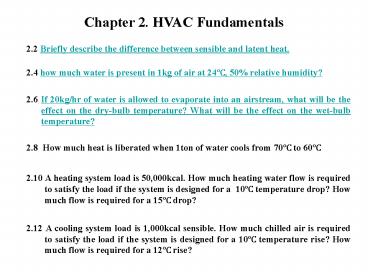Chapter 2' HVAC Fundamentals PowerPoint PPT Presentation
1 / 10
Title: Chapter 2' HVAC Fundamentals
1
Chapter 2. HVAC Fundamentals
2.2 Briefly describe the difference between
sensible and latent heat.
2.4 how much water is present in 1kg of air at
24?, 50 relative humidity?
2.6 If 20kg/hr of water is allowed to evaporate
into an airstream, what will be the effect on the
dry-bulb temperature? What will be the effect on
the wet-bulb temperature?
2.8 How much heat is liberated when 1ton of
water cools from 70? to 60?
2.10 A heating system load is 50,000kcal. How
much heating water flow is required to satisfy
the load if the system is designed for a 10?
temperature drop? How much flow is required for a
15? drop?
2.12 A cooling system load is 1,000kcal sensible.
How much chilled air is required to satisfy the
load if the system is designed for a 10?
temperature rise? How much flow is required for a
12? rise?
2
2.14 Your client desires an interior temperature
of 26?(78?) for the design of her HVAC system in
St. Louis(close to the airport weather station).
Assuming that a 5 percent design will be
satisfactory, what is the design temperature
difference?
2.16 What will be the heating load for below?
- Design condition inside 22?, outside
-14? - a wall 10m high by 50m long
- 150mm concrete, (Thermal conduction rate
0.55 kcal/mh?C) - 10mm gypsum
board(Thermal conduction rate 0.72 kcal/ mh?C)
- The furring space(10mm) is filled with
insulation at R-4 per inch (Thermal
conduction rate 0.012 kcal/ mh?C)
2.18 What will be the heating load for a 1.5
by1.5m window constructed of single-pane clear
glass according to the criteria in Question
14?Assume U1.05
2.33 How much heating load will be saved by
changing from R-4 to R-12 insulation in a 1,000m2
wall with an original U-factor of 0.15? Assume
the wall is located in a region with 4 months of
winter, average outside temperature -1 ?(30?),
inside temperature 25?(70?)
3
2.34 If the net cost of heating energy is ?6,000
per 100,000kcal/h, what will the utility cost
saving be for the wall change in Question 2.33?
2.39 A proposed building design has 100m2 of
glass with shading coefficient 0.7, equally
distributed north, south, east, and west. What is
the total solar load in tons on July 21 at 400
P.M.?
2.41 What would the solar load in tons for the
building in Question 2.39 be if all glass faced
north? How could this be accomplished while
maintaining views in all four directions?
2.42 If the initial incremental cost of
air-conditioning equipment is ?20,000 per
ton(R/T), how much less would the configuration
in Question 2.41 cost, compared with the
configuration in Question 2.39?
4
2.2.5 Sensible, Latent, and Total Heat
- Air contains thermal energy in two forms
sensible heat and latent heat - Temperature is a measure of sensible heat
- Humidity is a measure of latent heat
- Total heat is enthalpy(H) sensible heat
latent heat
5
2.2 Properties of Air-Water Mixtures
2.2.1 Psychrometry
6
2.4.5 Temperature Criteria
- Outside weather conditions affect heating and
air-conditioning loads - Historic extremes of temperature and humidity
are the basis for design - load calculations.
- Statistical data compiled for locations through
out the world are used - HVAC designer
- Outside design temperatures are selected on the
basis of a percent concept
7
Percent concept
- Heating load calculations
- - The percent concept assumes a heating season
of December through - February, which equals 2,160 hours per year
- - It imply the weather will be at or above the
listed condition only for the - specified percentage of 2,160 hours per year.
- - Percentage values 99 and 97.5
- Cooling load calculations
- - Summer is defined as June through September,
which equals 2928 hours - - Percentage values 1, 2.5, and 5
8
2.6.2 Conducted and Solar Heat through Glazing
- Solar effects must also be considered in
estimating heat gains through windows and
skylights. - These heat loads are considered in two parts
- simple conduction and solar transmission
SHGF solar heat gain factor(W/m2) SC shading
coefficient(dimensionless)
9
(No Transcript)
10
2.8.5 Windows
- The insulating quality of windows is key to a
buildings thermal performance - Typical double-glazed windows conduct heat at 25
to 50 times the rate of a well-insulated wall - Conventional glazing materials achieve better
winter performance with double or triple layers - Good summer performance is achieved by tints or
by reflective films that block the suns rays - Windows using the low-E concept are more
effective for lighting and view but keep heat in
during cold weather and keep heat out during hot
weather - Heat transfer through windows is affected by
U-factors and shading coefficients

